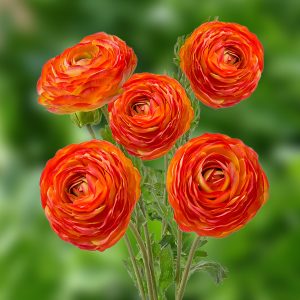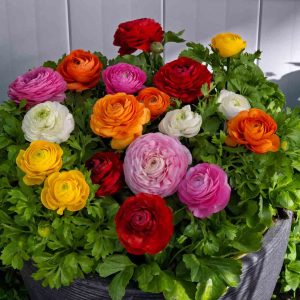Ranunculus flowers (Ranunculus spp.) are highly favored by florists and gardeners due to their vibrant colors, including yellow, pink, orange, red, purple, and white. These flowers are typically planted as tuberous corms during the fall in warmer regions, and they complement other spring-blooming flowers like daffodils, tulips, and hyacinths in borders or containers. There is a wide range of ranunculus species, varying from small yellow blooms known as buttercups to multi-layered, poppy-like flowers commonly used in bouquets. It’s important to note that ranunculus contains a level of toxicity that can be harmful to humans, as well as cats, dogs, and horses.

Common Name: Ranunculus, Buttercup, Butter Cress, Persian Buttercup. Crowfoot
Botanical Name: Ranunculus spp.
Family: Ranunculaceae
Plant Type: Annual, perennial, corm
Mature Size: 2 in. to 2 ft. tall
Sun Exposure: Full
Soil Type: Loamy, well-drained
Soil pH: Neutral
Bloom Time: Spring, summer
Flower Color: Yellow, pink, orange, red, white, purple
Hardiness Zones: 8-11 (USDA), native ranunculus 4-9 USDA
Native Area: North America, Eurasia
Toxicity: Toxic to cats, dogs, horses, humans1
Ranunculus Care
Ranunculus is a delightful flower that can be easily grown with proper planting. Although often sold as a spring bulb, it is actually a corm. In mild winter areas, plant the corms in the fall, while in colder regions, wait until early spring after the last frost.
 The blooming period of ranunculus depends on your growing zone, and they can be either annuals or perennials. After blooming, allow the foliage to naturally wither, as the plant continues to photosynthesize and store energy in its corms for the next season’s growth. In zones 8 to 11, corms usually overwinter in the ground or containers if undisturbed, but they must be protected from freezing temperatures. In colder zones 3 to 7, dig up, store, and replant the corms in spring. Flowering typically occurs around 90 days after planting. Apart from being cherished as cut flowers, ranunculus also attract pollinators and provide a food source for hummingbirds. Their vibrant colors and delicate blooms add beauty to any garden or floral arrangement.
The blooming period of ranunculus depends on your growing zone, and they can be either annuals or perennials. After blooming, allow the foliage to naturally wither, as the plant continues to photosynthesize and store energy in its corms for the next season’s growth. In zones 8 to 11, corms usually overwinter in the ground or containers if undisturbed, but they must be protected from freezing temperatures. In colder zones 3 to 7, dig up, store, and replant the corms in spring. Flowering typically occurs around 90 days after planting. Apart from being cherished as cut flowers, ranunculus also attract pollinators and provide a food source for hummingbirds. Their vibrant colors and delicate blooms add beauty to any garden or floral arrangement.
WARNING
It is important to note that certain species of ranunculus, particularly Ranunculus repens, have the potential to become invasive. Known as creeping buttercup, this plant produces small, dry achenes after flowering. As a weedy perennial, it can gradually spread and form large colonies, outcompeting native plants that are less vigorous. If you choose to include ranunculus in your garden, it is recommended to regularly trim and control the plants to prevent their aggressive spread. By taking proactive measures, you can enjoy the beauty of ranunculus without compromising the health and balance of your garden.
Planting
 The planting process for ranunculus corms varies depending on your growing zone. It is crucial to protect the cold-sensitive corms from freezing temperatures. In zones 7 to 10, plant the corms in the fall for early spring blooms that last longer than those planted in spring. Shield the area from freezing temperatures using a low tunnel or frost cloth. For zones 4 to 6, plant pre-sprouted corms in spring. About four weeks before the last frost date, soak the corms in room-temperature water (not exceeding 55 degrees Fahrenheit) for four hours, changing the water hourly. Fill a flat planting tray with lightly moistened grow mix, avoiding excessive moisture to prevent rot. Place the soaked corms in the tray with the tuberous fingers pointing down and cover them with an inch of moistened soil. Keep the tray in a cool, dark, and dry space, such as a basement. Ensure the soil remains slightly moist and check for mold daily, removing any rotted or moldy corms. Roots will form in approximately two weeks, signaling that the corms are ready for spring planting in the garden. Plant them 2 inches deep and 9 inches apart. In case of forecasted freezing, protect the area with a frost cloth.
The planting process for ranunculus corms varies depending on your growing zone. It is crucial to protect the cold-sensitive corms from freezing temperatures. In zones 7 to 10, plant the corms in the fall for early spring blooms that last longer than those planted in spring. Shield the area from freezing temperatures using a low tunnel or frost cloth. For zones 4 to 6, plant pre-sprouted corms in spring. About four weeks before the last frost date, soak the corms in room-temperature water (not exceeding 55 degrees Fahrenheit) for four hours, changing the water hourly. Fill a flat planting tray with lightly moistened grow mix, avoiding excessive moisture to prevent rot. Place the soaked corms in the tray with the tuberous fingers pointing down and cover them with an inch of moistened soil. Keep the tray in a cool, dark, and dry space, such as a basement. Ensure the soil remains slightly moist and check for mold daily, removing any rotted or moldy corms. Roots will form in approximately two weeks, signaling that the corms are ready for spring planting in the garden. Plant them 2 inches deep and 9 inches apart. In case of forecasted freezing, protect the area with a frost cloth.
Light
To promote successful blooming, select a planting location that receives full sun or at least 6 to 8 hours of sunlight daily. Insufficient sunlight may lead to fewer blooms and weaker stems.
Soil
For ranunculus species known for their vibrant blooms, opt for well-draining, nutrient-rich, loamy soil. Clay-based soils can cause the tuberous corms to rot if they become waterlogged. However, some native ranunculus species, such as Ranunculus repens, thrive in moist, heavier soils found near pond edges.
Water
After planting the corms in the ground or containers, maintain moist but not overly wet soil. Continue watering as the foliage and flowers emerge. As the flowers fade and the foliage turns yellow, gradually reduce watering, especially if you intend to dig up and store the corms for the next growing season.
Temperature and Humidity
Ranunculus flowers prefer cooler spring temperatures, typically in the 60s to low 70s Fahrenheit. They do not produce blooms and their foliage will die back once the heat and humidity of summer arrive.
Fertilizer
Since ranunculus flowers have a short growing season, they usually do not require fertilizer. However, before planting the corms, you can incorporate a granular fertilizer specifically designed for bulbs into the loose, loamy soil to provide additional nutrients.
Types of Ranunculus
Ranunculus encompasses a wide range of species, from native wildflowers to cultivated hybrids known for their stunning blooms
-
-
Ranunculus carolinianus: Also known as Carolina buttercup, this winter annual or short-lived perennial is found in low woods and damp thickets.
-
-
- Ranunculus flammula: Lesser spearwort or sagebrush buttercup, this native ranunculus produces small solitary yellow flowers on slender, creeping stalks. It thrives along lakeshores, pond margins, and in shallow water areas.
-
- Ranunculus repens: Creeping buttercup is a weedy perennial that grows up to 8-12 inches tall but spreads up to 36 inches wide. Originally from Europe and Asia, it has naturalized in temperate regions across the United States and Canada.
-
- Ranunculus asiaticus: This tuberous-rooted plant features parsley-like leaves and blooms in late spring to early summer. Known as Persian buttercup, its cup-shaped flowers resemble poppies and come in various colors including red, pink, purple, yellow, and white. The flowers have distinctive purple-black anthers and typically grow on stems ranging from 12 to 24 inches tall.
-
- Ranunculus asiaticus x hybrids: Florists often sell ranunculus flowers that are hybrids bred for specific qualities such as stem length, size, color, and petal count.
-
- Ranunculus asiaticus x Cloni Success ‘Venere’: This variety showcases hot pink ruffled blooms with sturdy stems, making it ideal for cut flower arrangements.
-
- Ranunculus asiaticus x ‘Elegance Giallo’: With its vibrant yellow color, this variety is a long-lasting cut flower.
-
- Ranunculus asiaticus x Amandine ‘Salmon’: Exhibiting warm salmon-colored blooms ranging from light orange to pink.
-
- Ranunculus asiaticus x La Belle ‘White Picotee’: This variety features cream-colored petals edged in violet and pink.
-
- Ranunculus asiaticus x Pon-Pon ‘Hermione’: Known for its large flowers with ruffled pink and white petals, it reveals a green center eye when fully opened.
Pruning
 During the growing season, there is no need for pruning. However, once the foliage of the plants turns yellow and dies back, it can be pruned down to the ground. Whether you choose to leave the corms in the ground or remove them, cutting back the dead foliage is recommended. It’s worth noting that certain native ranunculus species, such as Ranunculus repens, can become weedy and invasive. To prevent them from spreading excessively, it is necessary to remove and control their growth. Regular monitoring and management will help maintain their growth within desired limits.
During the growing season, there is no need for pruning. However, once the foliage of the plants turns yellow and dies back, it can be pruned down to the ground. Whether you choose to leave the corms in the ground or remove them, cutting back the dead foliage is recommended. It’s worth noting that certain native ranunculus species, such as Ranunculus repens, can become weedy and invasive. To prevent them from spreading excessively, it is necessary to remove and control their growth. Regular monitoring and management will help maintain their growth within desired limits.
Propagating Ranunculus
To propagate ranunculus flowers, dividing the corm and its offsets is the most common method at the end of the growing season. Here’s a step-by-step guide:
-
- Once the foliage has turned yellow and died back, cut the plant down to ground level.
- Carefully dig up the corms, making sure to shake off or wash away any soil. Remove any dried leaves or stems that are still attached.
- Using sharp garden shears, divide the small offshoots, known as cormels, from the main corm.
- Allow the corms to dry in a cool and dry place. Store the dry tuberous roots in a dry environment with temperatures between 50 to 55 degrees Fahrenheit (10-13 Celsius).
- In mild areas, plant the corms in the fall. Alternatively, you can soak the corms in room-temperature water and pre-sprout them for spring planting.
- When planting the corms, ensure that the tuberous roots are facing downwards. Plant them at a depth of 2 inches and space each planting approximately 9 inches apart.
How to Grow Ranunculus From Seed
If you want to grow ranunculus from seeds, follow these steps to ensure successful germination and transplanting:
-
- Prepare a seed starting tray by filling it with moist but not waterlogged growing mix.
- Generously sprinkle ranunculus seeds on top of the growing mix. Lightly cover the seeds with a thin layer of seed starting mix, then gently press the soil down.

- Place the tray under a grow light and maintain a temperature of around 50 degrees Fahrenheit. Germination should occur within 20 to 30 days.
- Once the seedlings reach a height of approximately 2 inches, thin them out by removing excess plants, allowing the strongest ones to thrive. Continue growing them under the grow lights.
- Transplant the seedlings into 2- to 3-inch pots. Begin the hardening-off process when daytime temperatures reach the upper 40s. This involves gradually exposing the seedlings to outdoor conditions, bringing them indoors at night or during frosty weather.
- When the weather consistently reaches temperatures in the upper 50s to 60s Fahrenheit, the seedlings can be planted in the garde
Overwintering
The approach to overwintering ranunculus depends on your hardiness zone. In zones 8 through 11, the corms can be left in the ground or in containers. However, in regions with heavy rainfall, it’s important to prevent waterlogging and rot. For zones 3 through 7, dig up the corms, remove the soil, and allow them to dry. Store them in a cool, dry location in a mesh bag at temperatures between 50 and 55 degrees Fahrenheit.
Common Pest & Plant Diseases
Although aphids can be a concern, there are no other major pests that commonly affect ranunculus. However, overwatering and planting in clay soil can lead to root rot.
How to Get Ranunculus to Bloom
To encourage ranunculus to bloom, ensure they are planted in a location that receives full sun. While plants grown from seed may have fewer blooms initially, they will typically produce more as the corms mature in the following seasons.
Common Problems With Ranunculus
-
- Overwatering
-
- Planting in clay soil
-
- Not enough sun
-
- Freezing temperatures




